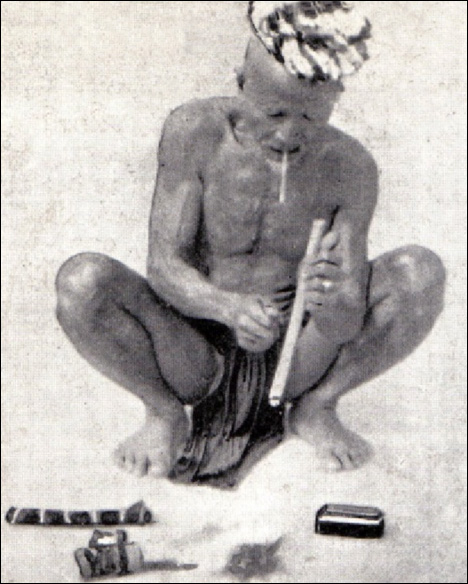
History and Distribution of the Bamboo Strike-A-Light
by Tom Lourens
Introduction
The bamboo strike-a-light is a relatively unknown method of spark-based fire starting that has been overlooked in the modern bushcraft and survival scene, and has largely been ignored by scientific literature. Like the fire piston and fire thong methods of fire-making, it has an exclusive Southeast Asian distribution. The method consists of striking sparks out of the culm of Schizostachyum bamboo with flint, broken pottery, china or even another piece of bamboo. The sparks that occur by striking the Schizostachyum bamboo are presumably generated by the high silica content in this genus of bamboo.
Historical Distribution
The first accounts of this remarkable method of creating fire by striking stone or pottery onto a bamboo culm to produce sparks came from marooned travelers in the Indonesian archipelago at the end of the 18th century 28. From then on different naturalists (most famous amongst them, Alfred Russel Wallace in his book The Malay Archipelago 27), anthropologists and adventurers mention the bamboo strike-a-light briefly from several other locations in Southeast Asia as well in their travelogues and ethnological accounts.
Philippines
The South Western Philippine islands of Balabac & Palawan are the origin of some bamboo strike-a-light sets that are in the American Museum of Natural History. The American ethnologist and museum curator Walter Hough described them in 1928 13.
The island of Borneo
The bamboo strike-a-light has been found in Northern and Central Borneo (the Malaysian parts of Sarawak & Sabah, Brunei and in Indonesian Kalimantan). In the 19th century, several naturalists and ethnographers, amongst them Beccari 3, Boyle 4, Skertchly 25, Roth 20 and Rutter 23, described the bamboo strike-a-light from the island of Borneo in their writings.

Figure 1 - Bornean man lighting his cigarette with a bamboo strike-a-light (Tillema, 1938).
In the first half of the 20th century, Tillema, a Dutchmen leading an expedition in 1931-1932 to the heart of Borneo, witnessed this method in the Apo Kayan area. In the book accompanying the expedition, he published the first pictures of a native man lighting his cigarette using this method (Figure 1) 26. He writes that he filmed the process as well, but the clip did not end up in his 1933 film about the expedition. In 1944, during the second world war, an army plane was shot down above Borneo and with the help of some natives, the airmen managed to survive in the jungle of the border area between Sarawak and Kalimantan. They described the bamboo strike-a-light being used by their guides in the narrative of their misfortunes; The Airmen and the Headhunters 11. The method was also described from the same region in a book by Eric Hansen, On Foot Across Borneo 10. In 2007, BushcraftUK member Ash Kivilaakso found that the knowledge on this method of fire starting still lingers on in the Brunei/Sarawak border area. Jamit, an Iban headman showed him the bamboo species that was used and later Salang, another elder, gave a tutorial for making the accompanying tinder 5.
Molucca’s (Indonesia)
The area around Palu on the NorthWestern coast of Sulawesi (= Celebes) is where the marooned Captain Woodard and his fellows saw the bamboo strike-a-light in use in the late 1800´s 28. Riedel 19 describes the method from Minahassa, another part of Northern Sulawesi. Ceram, the Ceram Laut islands, Ternate and the Banggai islands are all mentioned by Lagercrantz 14 (Ternate also by Wallace 27). Halmahera and Kisser (= Kisar) island are extra Moluccan locations given by Pleyte and Wilkes 18.
Irian Yaya (Indonesian part of New Guinea)
The bamboo strike-a-light was found in the following areas in Irian Yaya, the Western part of New Guinea: Waigeo island 18, Vogelkop, Arfak 9, 29, Yapen 16, Biak 12, 14, Mamberano river basin 9, 12, 15 and "massif de Yeleme" in the Central highlands, the home of the stone axe producing Wano tribe 9, 16, 17.
Asian mainland; Burma,‘Cochin China’ & North East India
Two other areas situated on the Asian mainland were also mentioned in literature; Burma (apparently described by German anthropologist Adolf Bastian according to the 9th Edition of Encyclopedia Britannica) and the former "Cochin China" (nowadays the Laos/Cambodia/Vietnam area, Frederick Boyle saw the method in use here, once again the source is the Encyclopedia Brittanica). As both areas are only found in indirect citations concerning the bamboo strike-a-light, these two areas must be met with some skepticism. Boyle described the method in his Adventures Amongst the Dyaks of Borneo 4 and also wrote about Cochin China. His account of the method being used in Cochin China might represent a misconception or misquoted sentence.
A recent find in literature of the bamboo strike-a-light being used by the Dafla (or Nyishi/Nishi) people from the state of Aruchanal Pradesh (North East India) 24 greatly expands the distribution of the method. As this area is close to the Burmese border, it gives more credit to the claim of Bastian about the bamboo strike-a-light in Burma.
Ethnological collections
Specimens of the bamboo strike-a-light can be found in several ethnological museums around the world. With their accompanying data, and the information from travelogues and other accounts, a fairly comprehensive distribution for the bamboo strike-a-light method of fire starting can be made (Figure 2).
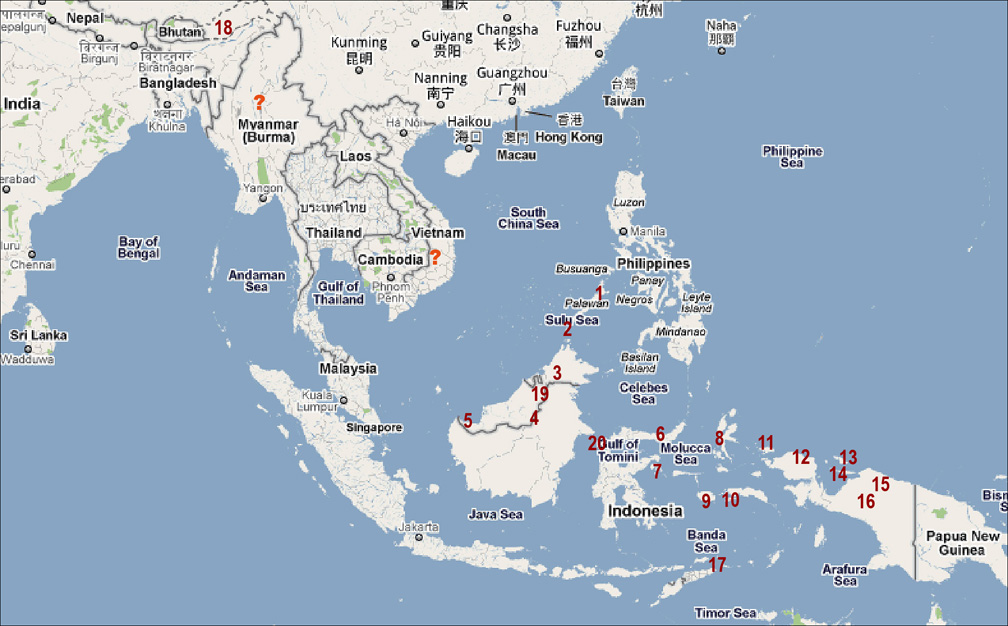
Figure 2 - Distribution of the bamboo strike-a-light method of fire starting.
1. Palawan island, Philippines (Hough, 1928)
2. Balabac island, Philippines (Hough, 1928)
3. Sabah (several locations) Borneo, Malaysia (Skertchly, 1890, Roth, 1896, Rutter, 1929)
4. Apo Kayan and Sarawak/Kalimantan border area, Borneo, Malaysia/Indonesia (Tillema, 1938, Hansen, 1988, Heiman 2007)
5. Sarawak (´Kuching area´), Borneo, Malaysia (Beccari,1902)
6. Minahassa, Sulawesi island, Moluccas, Indonesia (Lagercrantz, 1954)
7. Banggai islands, Moluccas, Indonesia (Lagercrantz, 1954)
8. Ternate island, Moluccas, Indonesia (Wallace 1869)
9. Ceram island, Moluccas, Indonesia (Lagercrantz, 1954)
10. Ceram Laut islands, Moluccas, Indonesia (Lagercrantz, 1954)
11. Waigeo island, Irian Yaya, Indonesia (Hough, 1928)
12. Vogelkop (Birds Head area) or Arfak area (Atam, Moiree, Ajawasi), Irian Yaya, Indonesia (Stichting Volkenkundige Collectie Nederland, http://www.svcn.nl/collectie.asp search-item: "vuurmaker")
13. Biak island, Irian Yaya, Indonesia (Lagercrantz, 1954, Held, 1954)
14. Yapen island, Irian Yaya, Indonesia (Petrequin and Petrequin,1993)
15. Mamberano river basin (Waropen area/Kauwerawet-tribe/Duvle tribe), Irian Yaya, Indonesia (Le Roux, 1928, Held, 1954, van Eechoudt, 1962, Petrequin and Petrequin, 1993)
16. Wano tribe,"Massif de Yeleme", central highlands, Irian Yaya, Indonesia (Petrequin and Petrequin,1993)
17. Kisar (Kisser) island, Moluccas, Indonesia (Pleyte and Wilkes,1893)
18. Dafla (or Nyishi/Nishi) tribe, Lower Subansiri District of Arunachal, North East India (Shukla, 1965)
19. Brunei/Sarawak border area (Ash Kivilaakso/Jamit/Salang, 2007)
20. Northwest Sulawesi (Woodard, 1805)
There are two vague references, marked with a question mark:
"Burma" (apparently mentioned by 19th century anthropologist Adolf Bastian)
"French Cochin China" (the Vietnam/Cambodia/Laos area, apparently witnessed in the 19th century by Frederick Boyle this might be due to an error though, see text). According to Roussel (2005) Walter Hough (1928) mentions"Southern Vietnam")
Scientific Literature on the Subject of the Bamboo Strike-A-Light
The first to focus on the bamboo strike-a-light in a scientific article on primitive fire starting was S.B.J. Skertchly 25. He described how Pandeka, his native helper, made 'fire from bamboo and pottery', using a bit of broken crockery on bamboo to light tinder made from scrapings from the inside of bamboo. In 1893, the bamboo strike-a-light was mentioned by Pleyte and Wilkes amongst other primitive fire starting techniques in an ethnological encyclopedia on the Indonesian archipelago 18, at that time a Dutch colony. The encyclopedia article lists some areas of Dutch Indonesia where the bamboo strike-a-light could be found in use, including Kisser (Kisar), but gives no further references. The authors give a plausible origin of the bamboo strike-a-light by saying that in a pre-metal environment, sparks must have been observed frequently when striking this type of bamboo with a stone axe. This ability to produce sparks may also be the origin of the special status of the `temiang´ bamboo and it´s ceremonial uses in the Brunei/Sarawak area, as witnessed by Ash Kivilaakso in the first decade of this millenium.
Walter Hough, curator of the United States National museum and writer/practicer of native fire starting methods, acquired some examples of the bamboo strike-a-light for his museum from Balabac and Palawan, two islands belonging to the Philippines that are situated North of Borneo. He was the first to publish pictures of bamboo strike-a-light specimens in 1928 13.
At the beginning of the 20th century, Mr. Hough corresponded with Henry Balfour (curator of the Pitts-Rivers museum in England and, like Hough, another giant in the field of writing articles on primitive firestarting) about the bamboo strike-a-light. A monograph on this method, like Balfour had written earlier on the fire piston 1 and fire thong method 2, never saw the light of day.
Lagercrantz mentioned the bamboo strike-a-light in his African Methods of Fire-making 14 and included some new locations where the method was used, but the French research couple Petrequin and Petrequin were the first to give a detailed description of the bamboo strike-a-light in use in modern times 16. In the early nineties of the 20th century, they researched the fabrication of polished stone axes by the Wano tribe of Irian Yaya on the island of New Guinea. During this study, they encountered this peculiar method of fire starting and even managed to capture it on film 17. According to the Petrequins, the bamboo strike-a-light was probably introduced in quite recent times from the island of Yapen (where they later found it still in use as well) by the trade route up the Mamberano river valley. This theory is backed up by Held´s earlier work on the Papuans of Waropen 12 in the Mamberano valley region. He stated that the bamboo strike-a-light came to them from Biak, an island next to Yapen. Van Eechoud 7 says the bamboo strike-a-light only replaced the rattan fire thong as the main method of fire making by the Kaowerawédj tribe “within the time of two generations”.
The Petrequins speculate that the sparks are generated by friction of the stone/pottery to phytoliths (literally: 'plant-stones', microscopic plant structures that contain silicate) on the culms of the bamboo and also state that the bamboo strike-a-light specimens could easily be overlooked or misclassified in museums as the bamboo culms used often double as a container in daily use.
As there are a number of 'primitive' fire starting methods in use in Southeast Asia, the bamboo strike-a-light is not the only technique used to create fire. The Wano people normally use the fire thong and revert to the bamboo strike-a-light in heavy downpours when conditions apparently are too adverse for the fire thong.
Hampton 9 also reports about the bamboo strike-a-light (he calls it the “Wano bamboo matchbox” in his work Culture of Stone) and says that the Duvle speaking lowland people to the North of the Wano tribe also use this kind of fire starting as do the “Melanesians who live in the interior of the Birds Head area”.
The first article solely dedicated to the bamboo strike-a-light was written by another Frenchman, Dr. Bertrand Roussel 21. His article starts with a myth from the Murut, a people from the North of Borneo, that tells how a dog lead their people to the discovery of their fire starting method. He then proceeds to describe the bamboo strike-a-light, its distribution and tries to specify the species of bamboo that is used. Roussel comes up with Schizostachyum lima as the prime candidate, based on linguistical evidence from the Philippines and the distribution of both method and bamboo species. A condensed version of Roussel´s article can be found in his book on primitive fire starting methods, La grande aventure du feu 22.
There is probably far more to be found about the history and distribution of the bamboo strike-a-light as the recent addition of the Subansiri region in North East India to the historical distribution of this method shows. There are many blanks on the map between the locations. The rather sketchy geographical distribution is proof that there is more to expect. So, if you happen to travel to the lesser visited areas of the South East Asian region, keep your eyes open! And if you find this method mentioned in an old travelogue or anthropological journal, come across a museum specimen with new locations for the bamboo strike-a-light or find another clue to this amazing method of firestarting, don´t hesitate to inform us.
References
1. Balfour, Henry The fire piston, 1907
2. Balfour, Henry Frictional fire-making with a flexible sawing-thong, 1914
3. Beccari, Odoardo Wanderings in the great forests of Borneo, 1902
4. Boyle, Frederick Adventures amongst the Dyaks of Borneo (p. 67), 1865
5. BushcraftUK-forum http://www.bushcraftuk.com/forum/showthread.php?t=10517
6. Clercq, F.S.A. de Ethnographische Beschrijving van de West- en Noordkust van Nederlandsch Nieuw-Guinea,1893
7. Eechoud, E.P.K. van Etnografie van de Kaowerawédj, 1962
8. Guillemard, F.H.H. The cruise of the Marchesa to Kamschatka and New Guinea, 1889
9. Hampton, O.W. Culture of stone (p. 35-36), 1999
10. Hansen, Eric On foot across Borneo, 1988
11. Heimann, Judith The Airmen and the headhunters (p. 107), 2007
12. Held, G.J. Papoea’s van Waropen (p. 351), 1947 (English version 1957)
13. Hough, Walter Fire-making apparatus in the United States National Museum, 1928
14. Lagercrantz, S. African methods of fire-making (p. 52-53), 1954
15. Le Roux De bergpapoea´s van Nieuw-Guinea en hun woongebied (p. 238), 1948
16. Petrequin, Anne-Marie & Petrequin, Pierre Ecologie d’un outil: la hache de pierre en Irian Jaya (Indonesie) (p. 95-97), 1993
17. Petrequin, Anne-Marie & Petrequin, Pierre La hache de pierre polie en Nouvelle-Guinée (DVD) 1991
18. Pleyte, C.M. & Wilken, G.A. Handleiding voor de vergelijkende volkenkunde van Nederlandsch-Indië (p. 655-656), 1893
19. Riedel, J.G.F. De Sluik-en Kroesharige Rassen Tusschen Selebes en Papua (p. 187), 1886
20. Roth, Henry Ling The natives of Sarawak and British North Borneo vol. 1 (p. 378) & vol. 2 (p. 208), 1896
21. Roussel, Bertrand Produire le feu par percussion avec le chaume d’un bambou, 2005
22. Roussel, B. & Collina-Girard, J. La grande aventure du feu, 2006
23. Rutter, O. The pagans of North Borneo, 1929
24. Shukla, Brama Kumar The Daflas of the Subansiri region, 1965
25. Skertchly, S.B.J. On fire-making in North Borneo (p. 450-451), 1890
26. Tillema, H.F. Apo-Kajan. Een filmreis naar en door Centraal-Borneo (p. 240), 1938
27. Wallace, Alfred Russel the Malay Archipelago, 1869
28. Woodard, David N. The narrative of Captain David Woodard and four seamen: who lost their ship while in a boat at sea, and surrendered themselves up to the Malays in the island of Celebes; containing an interesting account of their sufferings from hungar and various hardships, and their escape from the Malays, after a captivity of two years and a half: also an account of the manners and customs of the country, and a description of the harbours and coast, and c..., 1805
29. Stichting Volkenkundige Collectie Nederland, http://www.svcn.nl/collectie.asp (search-item: "vuurmaker")
The Search for the Fire Bamboo
by Ash Kivilaakso
It started simply. “Go and get me a type of bamboo”, said Tom Lourens, a primitive skills historian.
I had been following his BushcraftUK.com forum thread on the bamboo-strike-a-light. The most recent accounts, at that time, came from the late 1800’s and most were sketchy: the explorers described the method, but did not say where they had seen it except that it was somewhere in northern Borneo. Borneo is larger than Texas. Northern Borneo is the size of Washington State and covered in dense forests, swamps and mountains.
Tom had an idea that it might be one of the Schizostachyum species. The internet databases on bamboo did not clearly state where the possible species were found. But one Australian site did have a rough phonetic transcription of the local names in Malay, Javanese and Sudanese from hundred year old Dutch botanists’ notes. However. there are over 50 tribal languages in Borneo, they do not speak Javanese or Sudanese, and none of the explorers mentioned the tribe of their guides or the local name for the bamboo. Every native I asked looked blank.
After this encouraging start, I needed a beer. I was living in the only “dry” part of Borneo - a small Islamic monarchy - so I went to see an old friend who is an inn-keeper and bootlegger in Sarawak. He runs a shanty-town establishment at the “wet-dry” border crossing. It’s like a medieval inn for travelers. His booze comes at night in long slim boats up the narrow mangrove creeks after doing a high speed sea crossing from Labuan, a duty-free island and tax haven, which is used as a base for oil-exploration and money laundering.
But he is a good guy. Walk in and the first beer is on the house. The price is good and you’d be mad to run off without paying this ex-swamp logger, jungle-runner and contrabandista. He is a good bushman also, so I asked him about the bamboo strike-a-light. He looked blank too. He had never heard of such a bamboo. First rule for would-be researchers: most people under the age of 50 know little of the old ways. I tried the phonetic words pronouncing it different each time. No luck.
But then his eyes lit up, like a smuggler who happens upon an abandoned boat full of cargo. “Maybe it is temiang” (TEM -E-YOUNG).”Tell me about it,” I asked. “It’s used to make little baskets; it keeps spirits. When people died, the old ones used it for prayer and offerings. It’s special." Oh Great. So now I am hunting for a sacred fire bamboo, like an altar chalice or an ancestor’s funeral urn.
Armed with a new word, I decided to try my luck speaking to another old friend. Ignoring Kew Botanic Gardens' advice to look for the bamboo in the east, I struck west. Jamit is an Iban headman in his 70s: a barrel-chested, softly spoken man of few words who can improvise nearly everything with just his duku, the Iban long knife. I arrived in heavy rain. The road was washed away in places and bridges were in danger of collapsing. After greetings and small talk, I broached the subject.
Did he know of the bamboo-strike-a-light? Yes, he did. Did he know which bamboo was used? Yes. Could he show me where to get some? He could, but there is no need. Why? Because you know where it is. I do? Yes, you have used it many times. I have? To cook your meals in. That bamboo? Yes. Oh.
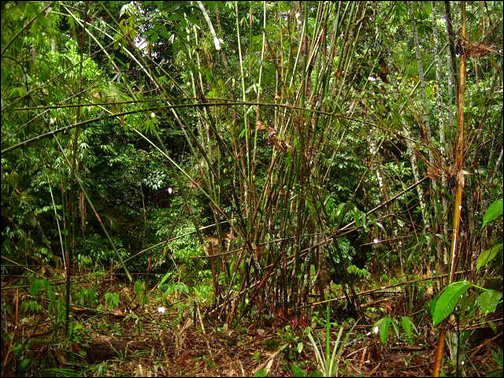
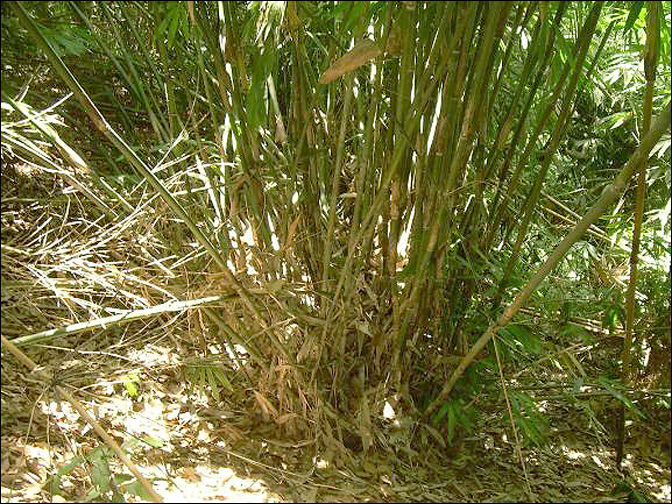
© A. Kivilaakso 2011
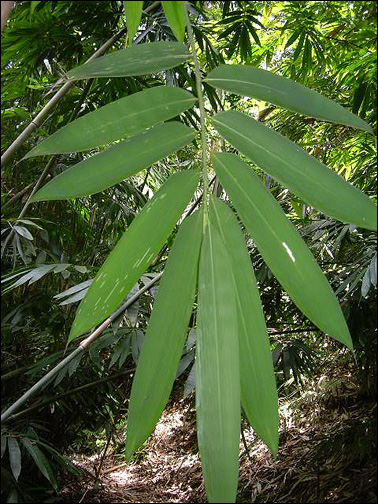
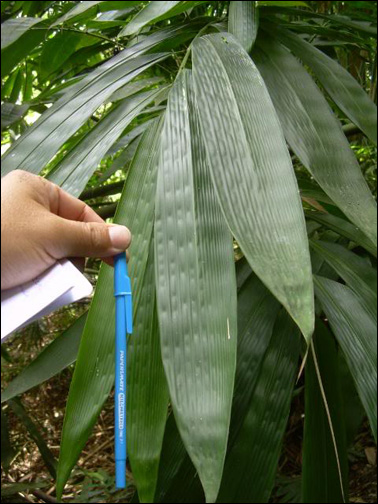
© A. Kivilaakso 2011
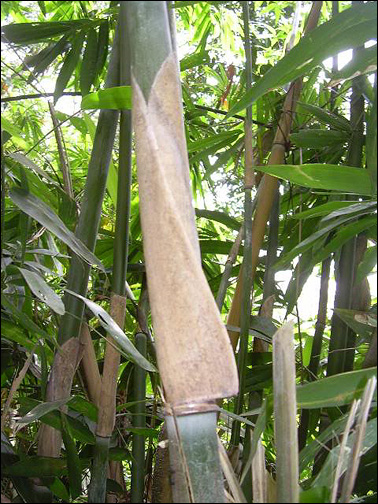
© A. Kivilaakso 2011
Temiang
So, we waited for the rain to stop and drank more tuak (long-house beer). I told him about the skepticism when early explorers said sparks could be made by striking two pieces of wood together.
The first known account of the bamboo strike-a-light dates from 1793, when the First Officer of the ship Enterprise and a crew of five in a ship’s boat, were separated from the mother ship by a squall in the Makassar Strait between Borneo and the Celebes. They were chased on sea and land by pirates, held hostage for ransom, escaped and were later caught repeatedly. Sometimes they got help from friendly natives. One of the things they saw was the bamboo strike-a-light. David Woodard later wrote a book about their adventures.
The rain did not stop and I was getting uneasy about submerged bridges, so I nagged him and we went to a nearby clump. He started to pick up fallen culms, choosing or discarding them by some test that I could not understand. Talking was impossible in the downpour. I left later with my bamboo stash without finding out what he had been doing.
Drying and then trying them out later with a piece of flint provided by Tom, I could make impressive, but short-lived, lines of sparks which fizzled out before reaching the tinder. David Woodard and his crew had the same problem. 18th Century seamen accustomed to using flint and steel daily were not able to use the strike-a-light. We had the tools, but not the touch.
Chastened, I returned to the longhouse where an elder showed me how to gather the tinder (same kind as the fire piston) while harvesting a millionaire’s salad for our meal. Our fresh heart of palm (Arenga undulatifolia) was much better than the one found in restaurants.
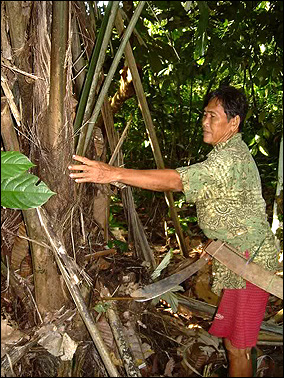
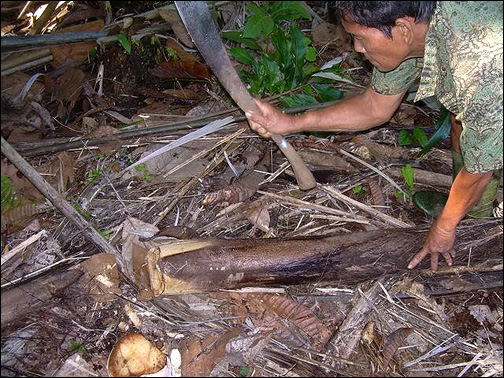
© A. Kivilaakso 2011
Apiang palm
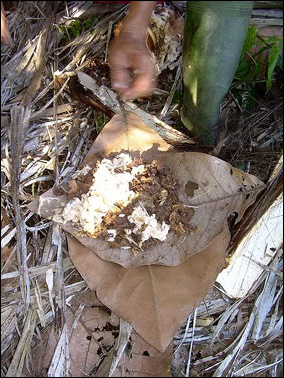
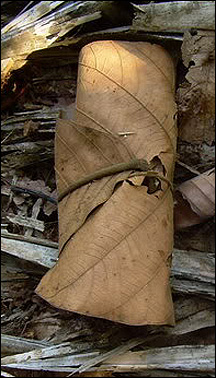
© A. Kivilaakso 2011
Apiang palm tinder (apiang lulut)
We laid the fluff from the inner layers out in the sun to dry. Later we charred giant pandanus to add to the dry fluff.
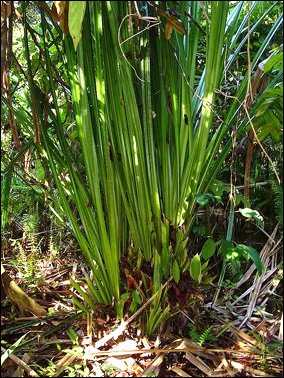
© A. Kivilaakso 2011
Giant Pandanus
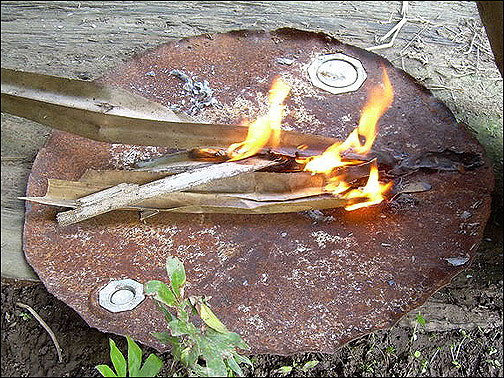
© A. Kivilaakso 2011
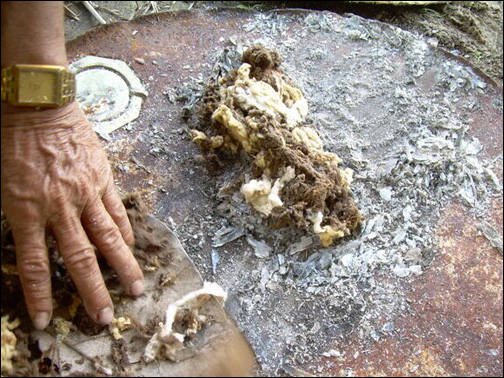
© A. Kivilaakso 2011
Once again, I was a modern man in a rush, this time to catch a plane, and I hurried him though the tinder was not yet bone dry.
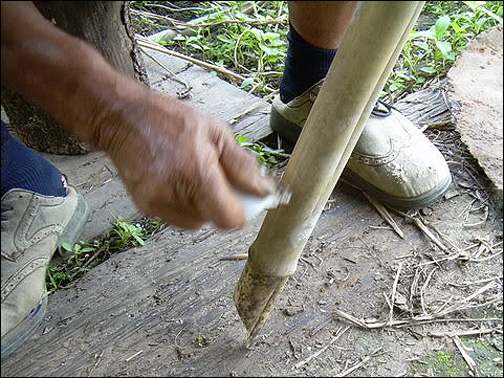
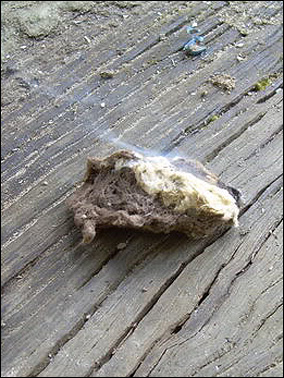
© A. Kivilaakso 2011
"A piece of fluffed up tinder is then placed on top of a piece of stone/crockery with the thumb on top in the conventional way and the temiang section is struck hard with a glancing blow. The tinder was not dry enough as it had barely 2 hours of direct sunlight to dry since being scraped off the inner stem. The crockery was also unsuitable being too modern though it threw off feeble sparks. We tried some robust ferrocium sparks to test the tinder. A very tiny part ignited, but even hand fanning only produced more smoke."
He threw sparks and set the tinder smoldering, but it would not catch. My fire steel could not do any better. At least I learnt the technique . . . . a shallow angled gliding strike.
The headman told me that the temiang clump was close to the longhouse for protection. Further down the only road out was another clump and others beyond that. This bamboo seems to act as a spiritual force-field to repel malevolent entities from entering the longhouse, like garlic and vampires. The clumps are not set up like a stockade, but aligned to some spiritual cardinal points. He also said that the bamboo had been brought there by his father about 60 years ago when his father left the Baram River to establish a new long house to the east. It was the ‘mother’ clump for the watersheds to the east of the longhouse. He gave permission to collect the young leaves to get DNA, which I sent to Ed Read at Cal State Fullerton in California. I also got cuttings for Professor K. M. Wong at UM, one of the top tropical bamboo experts, to identify.
There are at least three fire bamboo species – Schizostachyum jaculans in continental Asia, Schizostachyum iraten in Java and the Borneo one, which has yet to be definitively identified. Ed’s job is to do the DNA analysis. Professor Wong told me that he believed S. jaculans was a ‘village’ bamboo, meaning it was domesticated, much like cats and dogs, because of its use as a cooking utensil, blowpipe (due to the two yard plus internodal lengths) and for basketry. He has not found S. jaculans anywhere more than a kilometer (600 yards) from the site of an existing or derelict aboriginal settlement. He was not aware of the spiritual use of these bamboos. I was able to confirm that these bamboos traveled with the Iban head-hunters when this lively, war-like, democratic, and entrepreneurial tribe spread across Borneo Island. Strangely enough, in continental Asia, none of the aboriginal tribes I spoke to knew of the bamboo strike-a-light, even though they had the same bamboo in their backyard. Instead, they used it for making blowpipes and other things. However, some other Borneo tribes also know how to use the bamboo strike-a-light.
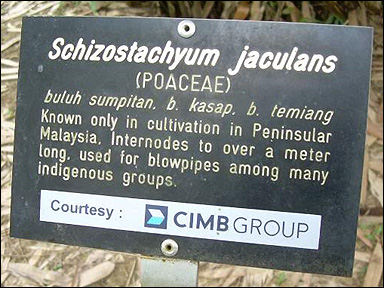
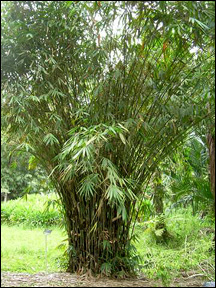
© A. Kivilaakso 2011
Schizostachyum jaculans
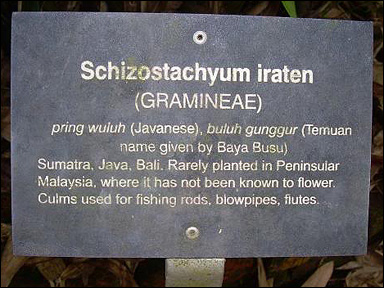
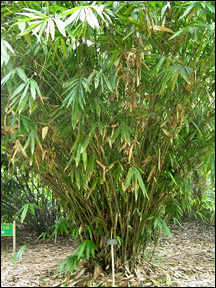
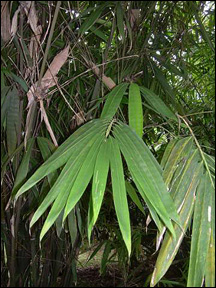
© A. Kivilaakso 2011
Schizostachyum iraten
Searching for the fire bamboo was a lot of fun. There are still adventures to be had and the quest is not over yet. Someone must visit the area where David Woodard was in Palu between 1793 and 1795 to get some specimens. Someone else must go to Western New Guinea where the fire bamboo is struck against a stone axe and bring axe and bamboo back. And a real Indiana Jones needs to go to the Eastern Himalayan jungle valleys of Burma, India and China to look for the tribes that use it there. Anyone care to come along?
E-mail your comments to "Ash Kivilaakso" in Malaysia at a.kivilaakso@gmail.com, "Tom Lourens" in the Netherlands at t.lourens@sanquin.nl, "Ed Read" in southern California at eread@exchange.fullerton.edu or "Dino Labiste" at KahikoArts@yahoo.com.
We hope the information on the PrimitiveWays website is both instructional and enjoyable. Understand that no warranty or guarantee is included. We expect adults to act responsibly and children to be supervised by a responsible adult. If you use the information on this site to create your own projects or if you try techniques described on PrimitiveWays, behave in accordance with applicable laws, and think about the sustainability of natural resources. Using tools or techniques described on PrimitiveWays can be dangerous with exposure to heavy, sharp or pointed objects, fire, stone tools and hazards present in outdoor settings. Without proper care and caution, or if done incorrectly, there is a risk of property damage, personal injury or even death. So, be advised: Anyone using any information provided on the PrimitiveWays website assumes responsibility for using proper care and caution to protect property, the life, health and safety of himself or herself and all others. He or she expressly assumes all risk of harm or damage to all persons or property proximately caused by the use of this information.
© PrimitiveWays 2017